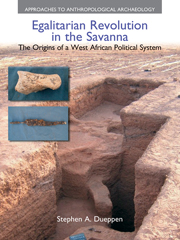Book contents
- Frontmatter
- Dedication
- Contents
- List of Figures
- List of Tables
- Acknowledgments
- 1 Decentralization and the Evolution of Egalitarian Behaviors in Sedentary Societies
- 2 Ancient Villages in the Niger Bend: Context and Methods for Exploring the Voltaic Region
- 3 Ethnographic Perspectives on Western Burkina Faso: A Survey
- 4 Kirikongo: An Introduction to the Site, the Setting, and the Research Design
- 5 The West African Environmental Setting: Kirikongo in Ecological Context
- 6 Stratigraphies and Depositional Episodes: The Excavations
- 7 Relative Chronology: Ceramics
- 8 Community Growth at Kirikongo: The Spatial and Temporal Setting
- 9 Early Sedentary Life in the Voltaic Region: Defining a ‘Voltaic Tradition’
- 10 Craft Production at Kirikongo: The Origins, Development and Reinterpretation of Specialization
- 11 Herding, Farming, and Ritual Sacrifice: The Economy from Kirikongo
- 12 Death and Ritual Objects at Kirikongo: House-Based Social Differentiation
- 13 Archaeological Patterns and Social Process: Reconstructing Changing Life at Kirikongo
- 14 Land, Spiritual Power, and Gerontocracy: An Exploration of the Roots of Egalitarian Revolution in the Western Voltaic Region
- 15 Hierarchy and Egalitarianism within the Niger Bend: Revolution and the Triumph of Communalism
- Bibliography
- Index
6 - Stratigraphies and Depositional Episodes: The Excavations
- Frontmatter
- Dedication
- Contents
- List of Figures
- List of Tables
- Acknowledgments
- 1 Decentralization and the Evolution of Egalitarian Behaviors in Sedentary Societies
- 2 Ancient Villages in the Niger Bend: Context and Methods for Exploring the Voltaic Region
- 3 Ethnographic Perspectives on Western Burkina Faso: A Survey
- 4 Kirikongo: An Introduction to the Site, the Setting, and the Research Design
- 5 The West African Environmental Setting: Kirikongo in Ecological Context
- 6 Stratigraphies and Depositional Episodes: The Excavations
- 7 Relative Chronology: Ceramics
- 8 Community Growth at Kirikongo: The Spatial and Temporal Setting
- 9 Early Sedentary Life in the Voltaic Region: Defining a ‘Voltaic Tradition’
- 10 Craft Production at Kirikongo: The Origins, Development and Reinterpretation of Specialization
- 11 Herding, Farming, and Ritual Sacrifice: The Economy from Kirikongo
- 12 Death and Ritual Objects at Kirikongo: House-Based Social Differentiation
- 13 Archaeological Patterns and Social Process: Reconstructing Changing Life at Kirikongo
- 14 Land, Spiritual Power, and Gerontocracy: An Exploration of the Roots of Egalitarian Revolution in the Western Voltaic Region
- 15 Hierarchy and Egalitarianism within the Niger Bend: Revolution and the Triumph of Communalism
- Bibliography
- Index
Summary
A variety of cultural processes have resulted in remarkable preservation of evidence from throughout Kirikongo's sequence. In particular, the practice of continual habitation of social groups in a specific locale, a social anchoring, contributed to formation of discrete deep mound deposits that stratify earlier habitation, and consequently protect these from erosion. But perhaps of greater significance to preservation are architectural techniques. The inhabitants of Kirikongo constructed highly durable pavements that effectively sealed strata and allowed little bioturbation. In addition, they tended to level an area ca. 20–40 cm above previous floors and leave in situ any objects not affecting the new floor surface. Thus, architectural remains (wall-stubs and floors) are visible in all mounds at various points in time. Most artifacts derive from highly specific provenience, aiding in the reconstruction of social processes.
In general, the mounds at Kirikongo were created by a diverse array of cultural processes that resulted in complex stratigraphies. There is no evidence at the site for periods of abandonment, as the stratigraphies of each mound indicate a continuous sequence of occupation. Below I describe the sequence for four excavation units (the fifth, Unit D, postdates the period under study). Units were excavated using a recording system designating individual ‘stratigraphic levels’ for each different deposit encountered (the excavation methodology is presented in detail in Chapter 4). In this chapter, based upon my analyses of the relationships between these stratigraphic levels, I combine them into culturally relevant depositional episodes, each marking an archaeologically visible ‘action’ in the past of varying temporal duration. These divisions are analytical tools; depositional episodes ranged from those produced during a single finite action, while others were processes that lasted over several phases of occupation.
- Type
- Chapter
- Information
- Egalitarian Revolution in the SavannaThe Origins of a West African Political System, pp. 83 - 114Publisher: Acumen PublishingPrint publication year: 2012



